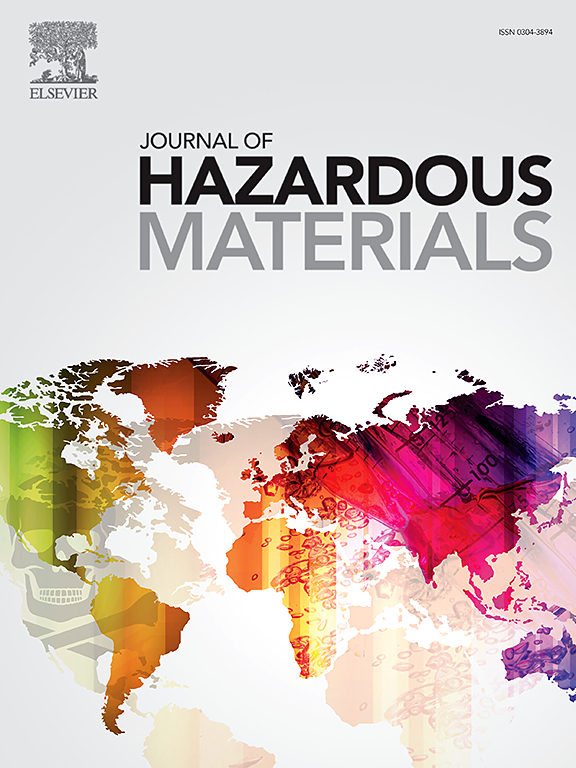DL-丙氨酸促进铜绿假单胞菌的定殖及其协同富硒作用和减少甘蓝菜对镉的吸收
IF 11.3
1区 环境科学与生态学
Q1 ENGINEERING, ENVIRONMENTAL
引用次数: 0
摘要
在富硒地区,土壤中硒和镉共存,对农产品安全构成威胁。本研究探讨了铜绿假单胞菌和dl -丙氨酸对甘蓝型油菜硒和镉吸收的影响。通过盆栽和培养基实验,以及FTIR和XPS分析,我们发现dl -丙氨酸显著促进铜绿假单胞菌生物膜的形成和根定植。与对照组相比,dl -丙氨酸与铜绿假单胞菌联合处理使地上部硒含量提高了55.8%,地上部和根部镉含量分别降低了66.3%和67.9%。造成这一结果的直接原因是根际土壤有效硒增加了32%,有效镉减少了10%。进一步研究表明,dl -丙氨酸促进铜绿假单胞菌将Se(0)转化为Se(-II)并形成CdSe纳米颗粒,从而提高硒的有效性,降低镉的有效性。此外,基因表达分析显示硒相关基因表达水平上调,而镉转运基因表达水平下调。本研究为硒镉共存土壤提高硒的利用和减少镉的吸收提供了一种新的方法,为更安全的农业实践提供了理论依据。本文章由计算机程序翻译,如有差异,请以英文原文为准。

DL-alanine promotes the colonization of Pseudomonas aeruginosa and their synergistic enrichment of selenium and decrease of cadmium absorption by Brassica napus
In selenium-rich regions, selenium and cadmium coexist in soil, posing a threat to agricultural product safety. This study explores the influence of Pseudomonas aeruginosa and DL-alanine on selenium and cadmium uptake in Brassica napus. Through pot and medium experiments, along with FTIR and XPS analyses, we found that DL-alanine significantly boosts Pseudomonas aeruginosa biofilm formation and root colonization. Compared with the control group, the combined treatment of DL-alanine and Pseudomonas aeruginosa increased the selenium content in the shoots by 55.8 %, and decreased the cadmium content in the shoots and roots by 66.3 % and 67.9 %, respectively. The direct reason for this result is that the available selenium in the rhizosphere soil increased by 32 % and the available cadmium decreased by 10 %. Further investigation shows that DL-alanine promotes the transformation of Se(0) to Se(-II) and the formation of CdSe nanoparticles by Pseudomonas aeruginosa, which enhances the availability of selenium and reduces that of cadmium. Furthermore, gene expression analysis revealed that the expression levels of selenium-related genes were upregulated, while those of cadmium transport genes were downregulated. This study proposes a new method for improving selenium utilization and reducing cadmium absorption in soils where selenium and cadmium coexist, providing a theoretical basis for safer agricultural practices.
求助全文
通过发布文献求助,成功后即可免费获取论文全文。
去求助
来源期刊

Journal of Hazardous Materials
工程技术-工程:环境
CiteScore
25.40
自引率
5.90%
发文量
3059
审稿时长
58 days
期刊介绍:
The Journal of Hazardous Materials serves as a global platform for promoting cutting-edge research in the field of Environmental Science and Engineering. Our publication features a wide range of articles, including full-length research papers, review articles, and perspectives, with the aim of enhancing our understanding of the dangers and risks associated with various materials concerning public health and the environment. It is important to note that the term "environmental contaminants" refers specifically to substances that pose hazardous effects through contamination, while excluding those that do not have such impacts on the environment or human health. Moreover, we emphasize the distinction between wastes and hazardous materials in order to provide further clarity on the scope of the journal. We have a keen interest in exploring specific compounds and microbial agents that have adverse effects on the environment.
 求助内容:
求助内容: 应助结果提醒方式:
应助结果提醒方式:


